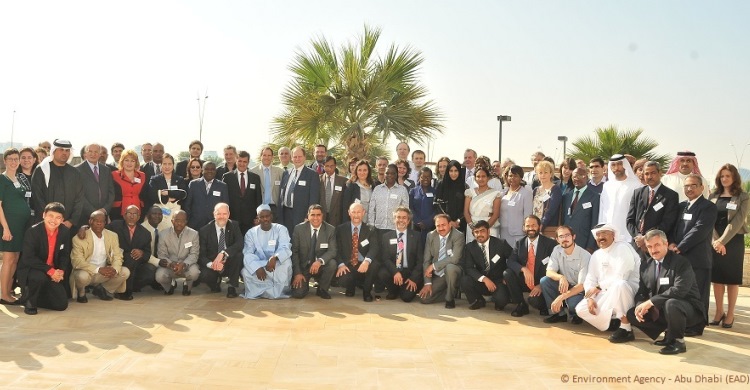Raptors MoU 1st Meeting of Signatories: More Countries Commit to Conserving Threatened Migratory Birds of Prey in Africa and Eurasia

Participants of the 1st Meeting of Signatories to the Raptors MoU. Photo © Environment Agency - Abu Dhabi.
Abu Dhabi, 12 December 2012– For the first time, 100 representatives from almost 50 countries came together to discuss urgent actions to step up international conservation efforts for threatened raptor species. Niger and Somalia both signed the Memorandum of Understanding on the Conservation of Migratory Birds of Prey in Africa and Eurasia (Raptors MoU), established under the auspices of the UNEP Convention on Migratory Species. This brings the total number of Signatories to 42.
At the First Meeting of Signatories to the Raptors MoU, held in Abu Dhabi, United Arab Emirates (UAE), countries reviewed the implementation of the overarching Action Plan and decided on future steps to promote this international raptor conservation agreement. A Coordination Unit was established which will be based in Abu Dhabi, funded by the Environment Agency - Abu Dhabi, on behalf of the Government of the UAE. Signatories also agreed to set up a 15-person Technical Advisory Group in early 2013, including experts from throughout the African-Eurasian region.
The Saker Falcon Task Force, established in 2012, is developing a Global Action Plan to conserve the species. Dramatic population declines of over 50% during the last 20 years led to the species being classified as Endangered on the IUCN Red List in 2012. In addition to major habitat changes affecting food availability, unsustainable or illegal capture, particularly for trade, has accelerated their decline. Saker Falcons have traditionally been trained for hunting purposes, especially in the Gulf States. Conservation success depends on the people who share the habitats with these birds, governments, conservationists and other stakeholders such as falconers, all working together to develop mechanisms to allow long-term sustainable use for falconry purposes.
Some migratory raptors have suffered major population declines in recent years. For example, European populations of the Egyptian Vulture have more than halved. African and Arabian populations are also decreasing. A project to train fieldworkers in Northern Africa has been established and aims to gather critical information about the ecology of this species on its wintering areas. Plans are also being developed to investigate the plight of the Sooty Falcon, a species specially adapted to breed in the harsh desert environments found in the Middle East and Gulf regions, but which annually flies South across coastal East Africa to winter on Madagascar. The aim is to bring together countries from all along its avian migration route to develop an international Action Plan tailored for the species.
Major threats faced by raptors are man-made. Habitat loss, due to settlements, industrial and infrastructure projects; intensive agricultural and other land-use practices can lead to serious declines in prey populations such as small mammals and birds. Hunting, poisoning and disturbance at nests increase the mortality rate of these birds of prey. In addition, contamination from pesticides and other pollutants can threaten the birds’ breeding success.
The decline of raptor populations has a direct impact on our natural environment as they provide invaluable ecosystem services. Vultures and other carrion eaters prevent the spread of disease by consuming dead animals. Many falcons act as biological pest control agents to the agricultural and horticultural industries by feeding on large numbers insects. Being on top of the food chain, these predators are indicators of the levels of prey populations and the overall health of the ecosystem.
76 migratory species of birds of prey and owls, which occur in 130 countries in Africa and Eurasia, are covered under the Raptors MoU. All birds of prey are exposed to a range of threats but migratory raptors are particularly at risk due to the often long and arduous annual journeys they make from their breeding grounds to wintering areas, and back again. The Convention on the Conservation of Migratory Species of Wild Animals provides a platform to ensure the long-term survival of these migrants along their avian migration routes. Governments are best placed to preserve a network of breeding, migration and wintering sites on which these nomads of the air can depend.
For more information please contact:
Nick P. Williams, UNEP/CMS Programme Officer (Raptors); email: [email protected] Tel: +971 (0)50 260 5569
Veronika Lenarz, CMS Secretariat; email: [email protected] Tel: +49 (0)228 8152409
Last updated on 03 April 2016


